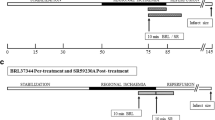CB receptor agonist HU-210 exhibits an infarction-limiting effect during in vitro reperfusion of the heart after focal ischemia. This effect is paralleled by a decrease in left-ventricular developed pressure and double product. In addition, HU-210 reduces end-diastolic pressure during the reperfusion period, which indirectly attests to reduced Ca2+ overload of cardiomyocytes.
Similar content being viewed by others
References
Lishmanov YuB, Maslov LN, Lasukova OV. Role of cAMP, cGMP, NO[synthase, KATP-channels and protein kinase c in development of cardioprotective effect of cannabinoid receptor agonist HU-210. Sib. Med. h. (Tomsk). 2012;27(2):115-119. Russian.
Maslov LN, Lasukova OV, Krylatov AV, Hanuš L, Lishmanov YuB. Mediated role of NO-syntase, protein kinase C and K ATP-channels in realization of cardioprotective impact of cannabinoid HU-210. Eksp. Biol. Farmakol. 2012;75(12):15-18. Russian.
Maslov LN, Mrochek AG, Schepetkin IA, Headrick JP, Hanus L, Barzakh EI, Lishmanov AYu, Gorbunov AS, Tsybulnikov SYu, Baykov AN. Protein kinases role in adaptive phenomenon of heart ischemic postconditioning development. Ross. Fiziol. Zh. 2013;99(4):433-452. Russian.
Menzorov MV, Shutov AM, Serov VA, Saenko YV, Grishenkin IY. Type of thrombolytic agent and rate of acute kidney injury in patients with myocardial infarction. Kardiologiya. 2015;55(2):16-20. Russian.
Vishnevskii AG, ed. The population of Russia in 2012. Twentieth annual demographic report. Moscow, 2014. Russian.
Tarasov RS, Ganyukov VL, Shushpannikov PA, Barbarash OL, Barbarash LS. Optimal timing of the second stage of revascularization in the treatment of patients with ST-elevation myocardial infarction and multivascular involvement. Kardiologiya. 2013;53(7):9-12. Russian.
Blatt A, Elbaz-Greener G.A, Mizrachi A, J’bara Z, Taraboulos T, Litovchik I, Vered Z, Minha S. Adjunctive mild hypothermia therapy to primary percutaneous coronary intervention in patients with ST segment elevation myocardial infarction complicated with cardiogenic shock: A pilot feasibility study. Cardiol. J. 2015;22(3):285-289.
Fryer RM, Hsu AK, Eells JT, Nagase H, Gross GJ. Opioidinduced second window of cardioprotection: potential role of mitochondrial KATP channels. Circ. Res. 1999;84(7):846-851.
Lasukova OV, Maslov LN, Ermakov SYu, Krylatov AV, Crawford D, Barth F, Hanus LO. Role of cannabinoid receptors in regulation of cardiac tolerance to ischemia and reperfusion. Biol. Bull. 2008;35(4):404-410.
Neckár J, Sźárszoi O, Herget J, Ostádal B, Kolár F. Cardioprotective effect of chronic hypoxia is blunted by concomitant hypercapnia. Physiol. Res. 2003;52(2):171-175.
Ostadal B, Kolar F. Cardiac Ischemia: From Injury to Protection. Boston; Dordrecht; London, 1999.
Pertwee RG. Pharmacology of cannabinoid receptor ligands. Curr. Med. Chem. 1999;6(8):635-664.
Shavadia J, Zheng Y, Dianati Maleki N, Huber K, Halvorsen S, Goldstein P, Gershlick AH, Wilcox R, Van de Werf F, Armstrong PW. Infarct Size, Shock, and Heart Failure: Does Reperfusion Strategy Matter in Early Presenting Patients With ST-Segment Elevation Myocardial Infarction? J. Am. Heart Assoc. 2015;4(8):e002049.
Yellon DM, Downey JM. Preconditioning the myocardium: from cellular physiology to clinical cardiology. Physiol. Rev. 2003;83(4):1113-1151.
Zhao ZQ, Corvera JS, Halkos ME, Kerendi F, Wang NP, Guyton RA, Vinten-Johansen J. Inhibition of myocardial injury by ischemic postconditioning during reperfusion: comparison with ischemic preconditioning. Am. J. Physiol. Heart Circ. Physiol. 2003;285(2):H579-H588.
Author information
Authors and Affiliations
Corresponding author
Additional information
Translated from Byulleten’ Eksperimental’noi Biologii i Meditsiny, Vol. 162, No. 7, pp. 33-36, July, 2016
Rights and permissions
About this article
Cite this article
Gorbunov, A.S., Maslov, L.N., Tsibulnikov, S.Y. et al. CB-Receptor Agonist HU-210 Mimics the Postconditioning Phenomenon of Isolated Heart. Bull Exp Biol Med 162, 27–29 (2016). https://doi.org/10.1007/s10517-016-3536-6
Received:
Published:
Issue Date:
DOI: https://doi.org/10.1007/s10517-016-3536-6



